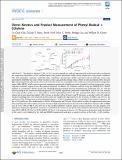| dc.contributor.author | Chu, Te-Chun | |
| dc.contributor.author | Buras, Zachary J. | |
| dc.contributor.author | Eyob, Brook | |
| dc.contributor.author | Smith, Mica C. | |
| dc.contributor.author | Liu, Mengjie | |
| dc.contributor.author | Green, William H. | |
| dc.date.accessioned | 2020-04-13T18:45:57Z | |
| dc.date.available | 2020-04-13T18:45:57Z | |
| dc.date.issued | 2020-03 | |
| dc.date.submitted | 2019-12 | |
| dc.identifier.issn | 1520-5215 | |
| dc.identifier.uri | https://hdl.handle.net/1721.1/124599 | |
| dc.description.abstract | The phenyl + ethylene (C6H5 + C2H4) reaction network was explored experimentally and theoretically to understand the temperature dependence of the reaction kinetics and product distribution under various temperature and pressure conditions. The flash photolysis apparatus combining laser absorbance spectroscopy (LAS) and time-resolved molecular beam mass spectrometry (MBMS) was used to study reactions on the C8H9 potential energy surface (PES). In LAS experiments, 505.3 nm laser light selectively probed C6H5 decay, and we measured the total C6H5 consumption rate coefficients in the intermediate temperature region (400-800 K), which connects previous experiments performed in high-temperature (pyrolysis) and low-temperature (cavity-ring-down methods) regions. From the quantum chemistry calculations by Tokmakov and Lin using the G2M(RCC5)//B3LYP method, we constructed a kinetic model and estimated phenomenological pressure-dependent rate coefficients, k(T, P), with the Arkane package in the reaction mechanism generator. The MBMS experiments, performed at 600-800 K and 10-50 Torr, revealed three major product peaks: m/z = 105 (adducts, mostly 2-phenylethyl radical, but also 1-phenylethyl radical, ortho-ethyl phenyl radical, and a spiro-fused ring radical), 104 (styrene, co-product with a H atom), and 78 (benzene, co-product with C2H3 radical). Product branching ratios were predicted by the model and validated by experiments for the first time. At 600 K and 10 Torr, the yield ratio of the H-abstraction reaction (forming benzene + C2H3) is measured to be 1.1% and the H-loss channel (styrene + H) has a 2.5% yield ratio. The model predicts 1.0% for H-abstraction and 2.3% for H-loss, which is within the experimental error bars. The branching ratio and formation of styrene increase at high temperature due to the favored formally direct channel (1.0% at 600 K and 10 Torr, 5.8% at 800 K and 10 Torr in the model prediction) and the faster β-scission reactions of C8H9 isomers. The importance of pressure dependence in kinetics is verified by the increase in the yield of the stabilized adduct from radical addition from 80.2% (800 K, 10 Torr) to 88.9% (800 K, 50 Torr), at the expense of styrene + H. The pressure-dependent model developed in this work is well validated by the LAS and MBMS measurements and gives a complete picture of the C6H5 + C2H4 reaction. ©2020 | en_US |
| dc.language.iso | en | |
| dc.publisher | American Chemical Society (ACS) | en_US |
| dc.relation.isversionof | 10.1021/acs.jpca.9b11543 | en_US |
| dc.rights | Creative Commons Attribution 4.0 International license | en_US |
| dc.rights.uri | https://creativecommons.org/licenses/by/4.0/ | en_US |
| dc.source | ACS | en_US |
| dc.title | Direct Kinetics and Product Measurement of Phenyl Radical + Ethylene | en_US |
| dc.type | Article | en_US |
| dc.identifier.citation | Chu, Te-Chun et. al., "Direct Kinetics and Product Measurement of Phenyl Radical + Ethylene." Journal of Physical Chemistry A 124, 12 (March 2020): 2352-2365 doi. 10.1021/acs.jpca.9b11543 ©2020 Author(s) | en_US |
| dc.contributor.department | Massachusetts Institute of Technology. Department of Chemical Engineering | en_US |
| dc.relation.journal | Journal of Physical Chemistry A | en_US |
| dc.eprint.version | Final published version | en_US |
| dc.type.uri | http://purl.org/eprint/type/JournalArticle | en_US |
| eprint.status | http://purl.org/eprint/status/PeerReviewed | en_US |
| dc.date.updated | 2020-04-06T15:09:58Z | |
| dspace.date.submission | 2020-04-06T15:10:03Z | |
| mit.journal.volume | 124 | en_US |
| mit.journal.issue | 12 | en_US |
| mit.license | PUBLISHER_CC | |
| mit.metadata.status | Complete | |
